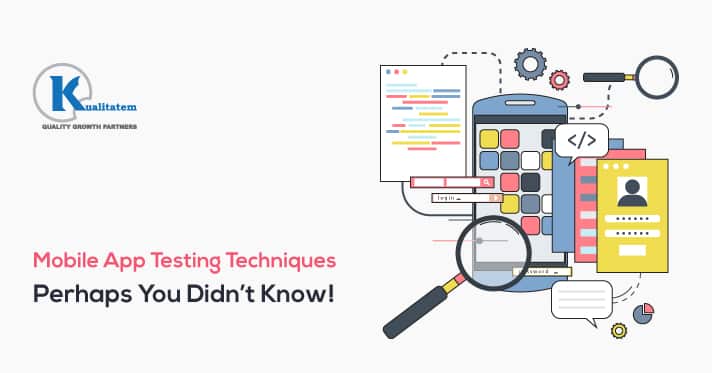Mobile App Testing Techniques Perhaps You Didn’t Know!

- December 28, 2018
- HibaSulaiman
Software can never be bug-free – ask any QA tester and they’d tell you the same. However, software testers have a broad range of testing skills and techniques to capture as many bugs and issues as possible.
“It’s working fine on my system.”
This has got to be the most frequent comment QA testers will get from developers when they report that the application is buggy or faulty.
And you know what a tester will reply to that?
“Well then, you might wanna back up your system because we need to deliver it to our customers without any further delay and it’s only working on your system. So…”
Of course, there is no way that developers can make a totally bug free software in one go. It’s just impossible. It’s the QA testers who need to invest their time and efforts to use their testing skills and techniques to identify the problem areas and point out as many bugs or issues as possible. Especially with mobile application testing, QA testers need a variety of techniques to detect issues in different environments and scenarios before the customers find them and tarnish your reputation.
In case you don’t have an in-house team, you can outsource your testing activities to mobile application testing companies for a more accurate and detailed checkup of your product.
The following guide on mobile testing techniques is a great place to start for QA testers and mobile application testing companies:
Interrupt Testing: Identify the Frustrating
Interruptions are hardly ever welcomed by anyone in their everyday life, but even more so in the mobile world. Nonetheless, they can be essential when they catch our attention towards something more important.
For instance, push notifications on a mobile device not only notify users about updated content, but most of them provide actions such as reply or delay. Hence, users can stay on top of their mobile activities and respond easily to anything that pops up.
On the contrary, mobile notifications can possibly cause a disruption if they hang in the middle of listening to music, sidetrack from tasks in another app, or perhaps slow down the device’s performance overall. With typically 50-80 interruptions per day from push notifications, it can become overwhelming for users. This supposed interrupt testing approach takes into account the disturbances caused by interruptions and proposes practical solutions to keep the mobile experience running smooth.
When executing interrupt testing, a mobile tester must generate every different notification type from the app on a real device to confirm that the actions and deep links are working. However, a mobile tester should also be able to test how the own app is able to handle interruptions from outside the app context. This could mean another push notification sent from perhaps another app or could be due to an incoming phone call while the application under test is active. The phone’s hardware could be a source of interruptions as well. For instance, pressing the volume buttons is again an interruption that is bound to affect the app.
When performing interrupt testing, a tester must watch out for UI problems, app crashes, or possible performance issues. Checking these characteristics can help to sidestep these interruptions and look for ways to keep the user experience a seamless process.
Input Testing: Emulate Real-World Scenarios
When testing a mobile app, a mobile tester must perform a variety of activities. These varieties are characteristically anything from feeding data into input fields to scrolling through lists and tapping on buttons. Nevertheless, smartphones offer sufficient additional input types to bear in mind and to perform during the testing phase.
Multi-Finger Inputs
Following the default one-finger input, modern touchscreens can process multi-finger inputs. There are two-, three-, and even four-finger gestures you can do for performing actions like zooming in, zooming out, or rotating the content of the screen.
Mobile testers must be aware of the different input gestures from the mobile platforms in addition to the gestures that are supported by the application and its features inside.
During the testing of these gesture inputs, it’s actually useful to modify the speed of the inputs using the fingers. For instance, try double-tapping the screen by one or more fingers or perhaps both hands even to observe how the app responds. Possibly, the app will not be able to process this and could crash.
Voice Inputs
Any app that is easily able to process sound and voice needs to be put to QA testing using real-world scenarios. These scenarios could either be in the office, on a random street, maybe the sub or train or perhaps in very quiet environments. The goal is eventually to see if the app is successfully able to process inputs correctly in the midst of any surrounding noise.
Based on the customer target base, the voice level, of course, might also be exciting to seek. For example, if the mobile application is strictly for kids, mobile testers need to ensure that they test the voice input using a real kid’s voice because it will be different from an adult voice.
Sensor Inputs
Based on the features of the tested app, a device’s sensors will possibly have an impact on its testing. Modern mobile devices come built with different sensors for collecting data from the surrounding environment. These sensors include:
- Light sensor
- Proximity sensor
- Acceleration sensor
- Gyroscope
- Magnetic sensor
- Pressure sensor
- Temperature sensor
- Humidity sensor
Mobile testers should be completely familiar with these sensors and also be aware of which app uses what features to rely on sensor data. However, again, these sensors need to be thoroughly put to test under different environments to evaluate their effect on the app. For example, if the application is using movement data, a potential test scenario that includes running and slowing down to understand how the app responds to change in movement speed.
There are still other mobile testing techniques that a mobile tester or mobile application testing companies should be completely aware of. These, in fact, should be performed during the development and testing stages:
- Hardware specific Testing
- Installation and update Testing
- Standby Testing
- Battery Usage Testing
- Local Storage Testing
- Beta Testing
- Testing Tours
Eventually, every tester needs to ensure that they develop a well-versed skill set to accomplish their testing goals. Having said that, it takes time, perseverance, and a lot of practice to achieve that stage. There is certainly no room for compromise when it successfully comes to launching high-quality digital products.











